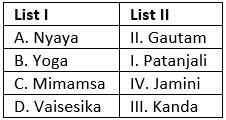Test: Important Question (Medieval India) - 1 - UPSC MCQ
30 Questions MCQ Test - Test: Important Question (Medieval India) - 1
The Harappan site of Mudigak is presently located in
Which of the following can be definitely be said to be the belief and practices of the Indus people?
I. Phallic and yoni worship as evident from the discovery of stone symbols
II. Worship of trees, animals and birds
III. Worship of idols of different gods
IV. Belief in ghosts and evil spirits
Select the answer form the codes given below.
II. Worship of trees, animals and birds
III. Worship of idols of different gods
IV. Belief in ghosts and evil spirits
Indus Civilization belongs to which of the following periods?
Given below are two statements — one labelled as Assertion (A) and the other labelled as Reason (R) :
Assertion (A) : Harappans exported raw cotton to Mesopotamia
Reason (R) : Harappans were the first to grow cotton
In the context of the above two statements, which of the following is correct?
Match the following Indus cities with the respective rivers on which they were located
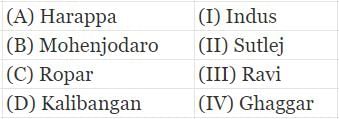
Codes:
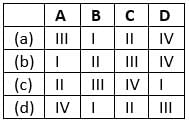
What is the chronological order of the discovery of the following Indus sites?
I. Kalibangan
II. Banwali
III. Chanhudaro
IV. Surkotada
V. Lothal
Choose the answer from the codes given below :
Match List I and List II and select the corr ect answer from the codes given below the lists :
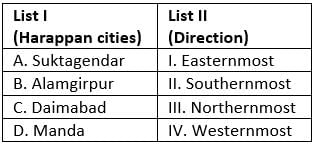
Codes:
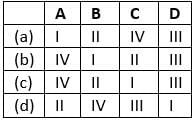
That men in some areas of India lived in underground pits is suggested by excavations in
‘Sutuduri’ mentioned in the Rig Veda is
Consider the following hymn of the Atharva Veda Samhita
“Even Though there were ten non Brahmin previous husbands of a woman, the Brahmin alone becomes her husband if he seizes her land.’’
This is an obvious reference to which of the following marriage practices of the Vedic people?
Which one of the following is not true regarding the Rig Vedic god Indra?
Match List-I and List-II and select th e answer using the codes given below the lists :
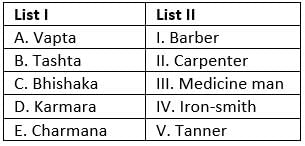
Codes:
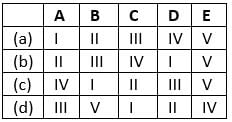
Given below are two statements — one labelled as Assertion (A) and the other as Reason (R) :
Assertion (A) : Atharva Veda Samhita is said to be the work of non-Aryans
Reason (R) : Its contents deal with philosophical topics like the Universal Soul, the Absolute, etc. In the context of the above two statements, which one of the following is correct?
Match List-I with List-II and select the answer from the codes given below
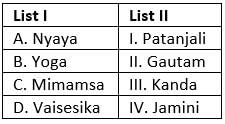
Codes:
A B C D
a) II I IV III
b) I II III IV
c) II I III IV
d) I IV III II
Which of the following statements about the later Vedic religion is not correct?
Which of the following are reasons for the identification of life reflected in the later Vedic texts with the painted grey were culture?
I. Material culture of the two corresponds
II. Geographical distribution of the two corresponds
III. Chronological span of the two corresponds.
IV. Both evolved locally
Select the correct answer from the codes given below:
The fertile agrarian tract in the early Tamil country is denoted by the term.
Consider the map given below
The places marked 1, 2, 3 and 4 respectively are
What is the correct sequence of the following in the history of south India?
I. Expansion of the Mauryan rule
II. Beginning of the megalithic culture
III. Sangam Age
IV. Pallava ascendancy
Select the correct answer from the codes given below:
In which hierarchical order does the Sangam literature describe the ‘Deva Vrinda’ as a group of five gods?
I. Siva
II. Krishna
III. Murugan
IV. Balaram
V. Indra
Select the correct answers from the codes given below.
Which of the following is/ are true regarding Buddhism?
I. It did not reject Varna and Jati
II. It challenged highest social ranking of Brahmin Varna
III. It regarded certain crafts as low.
Choose the correct answer from the codes given below.
The doctrine that the human personality consists of five skandhas is associated with
Match List I with List II and select the answer form the codes given below.

Codes:

Which of the following with is/are sacred to the Jainas?
I. Arbudagiri
II. Satrunjayagiri
III. Chandragiri
IV. Vrijayantagiri
Choose the correct answer from the codes given below.
Which of the following kingdoms was known for wealthy merchants professing Jainism and building Jaina temples?
Match List I with List II and select th e answer using the codes given below the lists
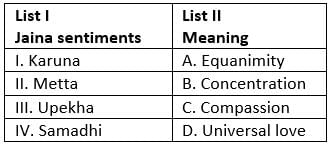
Codes:
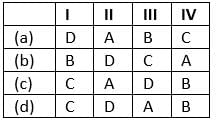
Which of the following were ruling powers in whose records the worship of Sakanda is found mentioned?
I. Satvahanas
I. Yaudhayas
III. Ikshavakus
IV. Chedis
Choose the correct answer from the codes given below
What is the significance of Kayavarohana in the history of Saivism?
Consider the following two statements-one labelled as Assertion (A) and the other labelled as Reason (R) :
Assertion (A) : The worship of the three emanations of Sankarshana, Pradyumna and Aniruddha declined from the Gupta period
Reason(R) : The concept of Vishnu's incarnations became popular and dominated Vaishnavism during the Gupta age.
In the context of the above two statements which one of the following is correct?



